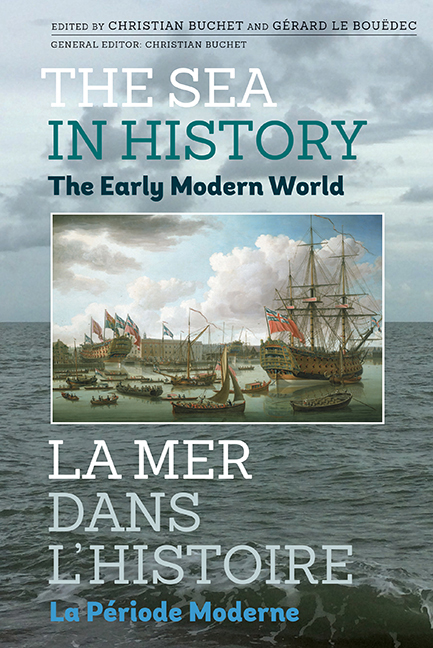Book contents
- Frontmatter
- Contents
- List of Illustrations
- List of Contributors
- Introduction générale et remerciements par
- General introduction and acknowledgements
- Introduction (français)
- Introduction (English)
- LA RÉUSSITE PAR LA MER:La reussite par la mer des territoires et des communautés littorales
- La construction d'un espace mondial: La circulation maritime et les ports
- La forte croissance de l'économie des pêches et des échanges
- Les acteurs de la dynamique maritime
- LA PUISSANCE MARITIME INSTRUMENT DE LA PUISSANCE POLITIQUE ET D'UNE STRATÉGIE GLOBALE DE RAYONNEMENT VOIRE DE DOMINATION: Les puissances maritimes occidentales
- L'océan Indien, entre convoitises et indifférences
- Les puissances maritimes asiatiques
- China's maritime world
- Le Japon et la mer
- Transformation of the maritime world in the Indonesian archipelago
- Corée: les navires garants de la souveraineté
- L'Afrique
- La politique maritime et l'idéologie
- Mer et développement technologique
- Développement maritime et maîtrise économique et financière
- Développement maritime et maîtrise organisationnelle
- Conclusion (français)
- Conclusion (English)
- Conclusion générale par
- General conclusion by
- Miscellaneous Endmatter
- Miscellaneous Endmatter
Transformation of the maritime world in the Indonesian archipelago
from Les puissances maritimes asiatiques
Published online by Cambridge University Press: 11 May 2017
- Frontmatter
- Contents
- List of Illustrations
- List of Contributors
- Introduction générale et remerciements par
- General introduction and acknowledgements
- Introduction (français)
- Introduction (English)
- LA RÉUSSITE PAR LA MER:La reussite par la mer des territoires et des communautés littorales
- La construction d'un espace mondial: La circulation maritime et les ports
- La forte croissance de l'économie des pêches et des échanges
- Les acteurs de la dynamique maritime
- LA PUISSANCE MARITIME INSTRUMENT DE LA PUISSANCE POLITIQUE ET D'UNE STRATÉGIE GLOBALE DE RAYONNEMENT VOIRE DE DOMINATION: Les puissances maritimes occidentales
- L'océan Indien, entre convoitises et indifférences
- Les puissances maritimes asiatiques
- China's maritime world
- Le Japon et la mer
- Transformation of the maritime world in the Indonesian archipelago
- Corée: les navires garants de la souveraineté
- L'Afrique
- La politique maritime et l'idéologie
- Mer et développement technologique
- Développement maritime et maîtrise économique et financière
- Développement maritime et maîtrise organisationnelle
- Conclusion (français)
- Conclusion (English)
- Conclusion générale par
- General conclusion by
- Miscellaneous Endmatter
- Miscellaneous Endmatter
Summary
ABSTRACT. From the start of the 15th century, the Indonesian archipelago was placed at the center of a Southeast Asian merchant network. What followed were significant mutations in the political domain with the development of city-states as well as the demographic and cultural domains. The author proposes that the relationship with the sea and its flows structures the entire history of the region. During the ‘Chinese century’ (1760–1830) that the author prefers to name the “Age of Chinaoriented trade,” the phenomenon gains in importance, creating retroactive loops beneficial to the strong economic development and high levels of immigration. The importance of Southeast Asian products in China is comparable in consequences to the Chinese tea trade, the Indian textiles for the northeast European countries and that of sugar for Japan. This active period culminates with the construction of new ports and cosmopolitan cities, favorable to the expansion of the Islamic and Christian religions and the spreading of the Malay language throughout the archipelago—today the national language of Indonesia.
RÉSUMÉ. L'Archipel indonésien dès le début du XVe siècle s'est trouvé inséré au coeur du réseau marchand du Sud-Est asiatique. Il s'en est suivi de profondes mutations tant au plan politique, avec le développement de cités-états, qu'aux plans démographique et culturel. Pour l'auteur, c'est le rapport à la mer et à ses flux qui structure toute l'histoire de la région. Le « siècle chinois » (1760- 1830) qu'il préfère appeler « l'âge de l'impulsion commerciale chinoise » (Age of China-oriented trade), le phénomène eut encore plus d'ampleur, créant des boucles de rétroactions favorisant un fort développement économique et une importante immigration. L'importance de la consommation des produits du Sud-Est asiatique en Chine est à comparer, par son ampleur et ses conséquences, au commerce du thé pour la Chine, aux textiles indiens pour les pays d'Europe du nord-ouest et à celui du sucre pour le Japon. Cette période active aboutit à la création de nouveaux ports et de cités cosmopolites, favorisant l'expansion des religions musulmane et chrétienne et répandant dans tout l'archipel la langue malaise, qui est aujourd'hui la langue nationale de l'Indonésie.
- Type
- Chapter
- Information
- The Sea in History - The Early Modern World , pp. 580 - 594Publisher: Boydell & BrewerPrint publication year: 2017



